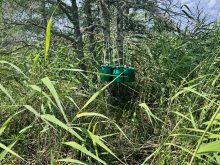While Mexicans gobble up 10 kilograms of beans per capita, the average se–or or se–orita only eats 100 grams of chickpeas a year.
So when Canadian chickpea growers look to Mexico they are eyeing up export potential, not demand. And that potential is awesome.
Oscar Sanchez of Maviga Mexicana said his country shipped a record 208,000 tonnes of chickpeas to markets like Spain and Algeria in 2001. Canada, by contrast, exported 190,000 tonnes of chickpeas that year.
Speaking to delegates at the Canadian Special Crops Association 17th annual meeting in Cancun, Sanchez said 85 percent of Mexico’s chickpea crop falls into the lucrative 12 millimetre category, with the rest split between the eight to nine mm category and a grouping that includes rejects and foreign material.
Read Also

Government, industry seek canola tariff resolution
Governments and industry continue to discuss how best to deal with Chinese tariffs on Canadian agricultural products, particularly canola.
Mexican growers planted 343,000 acres of chickpeas in 2002, almost all of which were kabulis. Some desi types were grown for cattle feed.
Last year’s production of 179,310 tonnes was down sharply from the previous year’s record crop of 221,000 tonnes. It is expected to fall again in 2003 because international demand for chickpeas has softened.
Sanchez is forecasting a small crop of 128,400 tonnes this year because acreage has dropped by 23 percent. But a 40,000 tonne carryover, which is the largest amount in the last decade, will boost the total supply available for export.
Mexico’s crop is sown between October and December and harvested from February through April.
Agricore United trader Martin Chidwick has heard estimates that the Mexican crop will be a lot smaller than Sanchez predicts, possibly as low as 80,000 tonnes.
“If that’s the case, that’s encouraging for the remnants of Canada’s crop and it may still impact what we do in two months time when we plant,” said Chidwick, who also sits on the CSCA’s board of directors.
Like Canadian farmers, Mexican growers are having a tough time coping with diseases such as fusarium and ascochyta.
They are also experiencing varietal degeneration problems, where buyers are seeing more “baldies” or smooth seeds and fewer that reach the sought after 12 mm size.
Shippers face stiff competition from emerging exporters such as Black Sea countries and Myanmar, which are undercutting both Canadian and Mexican product.
“(Those countries) are not necessarily driven by supply and demand so much as they are by having the U.S. dollar in their pocket,” said Chidwick.
But Sanchez said Mexican growers should soon have access to more disease-tolerant crops and he believes that if farmers keep producing 12 mm seeds, Mexico will remain the world leader in kabuli sales.
There was little discussion about the Mexican field pea situation at the conference, except for a brief presentation by Canadian embassy official Kim O’Neil, who said Canadian dry pea exports to Mexico have tripled since implementation of the North American Free Trade Agreement, moving from 4,713 tonnes in 1994 to 12,430 tonnes in 2001.
Mexico imports about 25 percent of the peas it eats and three-quarters of those imports come from Canada.
As for canaryseed, almost 100 percent of what Mexico consumes is supplied by Canada. Exports to that country were valued at $31 million in 2002.
“We rule in lentils. We rule more in canaryseed,” O’Neil said.

















